
Saturday, 7 August 2010
Picnic

People arrive with picnic tables, quickly set up on the shaded brick terrace near the house, then
covered with festive pink or green cloths. Food begins to arrive too, like the bowl of home-grown
cherry tomatoes - red, pink, yellow, black, and green. Several salads. Desserts are set aside
for later. The chapter ordered entrees from a local caterer: delicious paninis, salmon, and more.
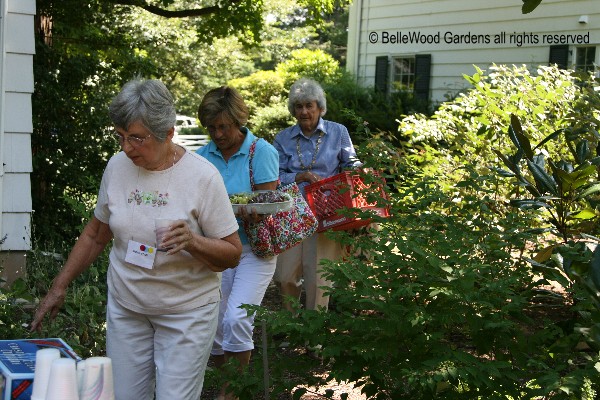
People keep coming, bearing food.
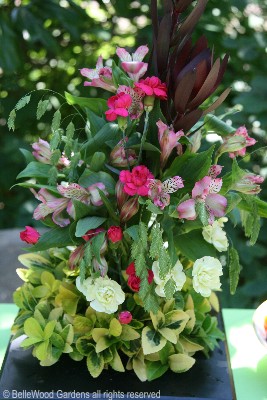
Even though Watnong is a chapter of the North American Rock Garden Society we're more soignee
than to decorate the table with a jumble of rocks. Carolyn created two exquisite flower arrangements -
and that's in addition to several hours spent helping Ann prepare for the picnic on Friday. We have great members.

Her checklist in hand, Ying, our picnic coordinator, takes one last look around as people start to queue
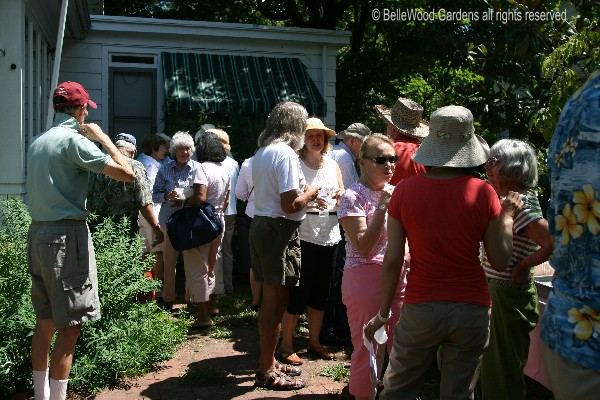
and more and more line up for the yummy food. It's a perfect day with comfortable temperatures,
low humidity, and gentle breezes. There's ample shade under a large katsura tree where we can sit
and eat and talk to friends. Conveniently close by to go back for seconds, for another glass of wine.
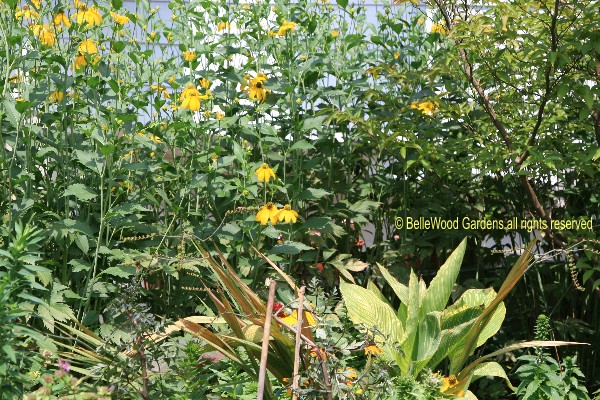
Canna 'Pretoria' makes a pleasant contrast to golden yellow daisies. Which one? I don't know.
It's like birders and their innumerable "sbb" - small brown bird." Taxonomists had to first divide
Compositae into tribes before they got down to genera. I'm having too pleasant a time to pursue
the identification. Might be a rudbeckia, could be a helianthus, might be . . . the plant knows.
UPDATE: Ann kindly replied, "The yellow flowered plants are Rudbeckia 'Herbstonne', a very well behaved plant. About 20 years ago I planted that row to form a screen to block off the air conditioners while we were sitting on the patio. They increase slowly by a spreading clump, but never reseed like some in that family. In June I cut them back drastically and then they fill out beautifully . Otherwise they get 5 or 6 feet tall and fall over when we have Summer storms."
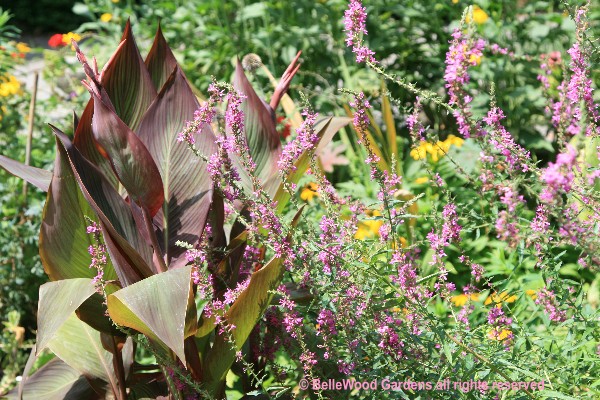
A purple leaved canna creates a bold contrast to bright pink-purple spikes of - is that lythrum?
UPDATE: Ann wrote, "I'm embarrassed that you mentioned the lythrum! About 4 or 5 years ago a 'bird', I presume, planted it as 3 blocks from here down toward the railroad that had been there for years. Mine remained one clump until this year when it took off, no doubt because of the damp, cool summer last year. I kept hoping to have time to remove all the flowers, but was swamped with weeds and so much maintenance that I didn't get to it and hoped no one would mention it as all good gardeners must know that it can be very invasive." All gardeners have such "embarrassments" in their gardens, Ann.
Years ago I planted Reynoutria japonica, also known as Polygonatum japonica. For over 5 years it was a pleasant dwarf plant, about knee high, with attractive reddish flower clusters in autumn. Then it decided to strike off for new territory. It's been more than 5 years of cutting back, digging up, spraying with Roundup® - and every year there's some more to evict. One British site suggests that it "can be effectively eradicated by repeated cutting (which exhausts the rhizomes), after initial clearing and burning on site, if possible further digging up or rotavation and then collecting as much of the root system as possible which should again be be burnt."
I remember many years ago at a garden club plant sale in Connecticut seeing bishop's goutweed, Aegopodium podagraria 'Variegata', being offered for sale. When I said this pretty plant with white variegations on its pale green leaves and lacy froth of white flowers was not a ground cover but rather a difficult to control thug of a plant the woman in charge of the booth told me, with some hauteur, "We call it a good doer." One way to cope with weeds in the garden is to avoid inviting in any plants that have territorial ambitions and the urge to take over more territory than the gardener in charge wishes to allow them.

A delicious smell wafts my way as I walk across the brick terrace. It's from Thymus herba-barona
growing in the cracks between the pavers. The caraway scent is delightful. "Oh yes," said Ann
our hostess. "It seeds in and is really a nuisance." Some people have a better class of weed than do I.

The party's over. On our way back out to the car I pause and photograph the netting over the hosta.
It seems that even in Short Hills, New Jersey the deer come sampling the front yard salad bar.